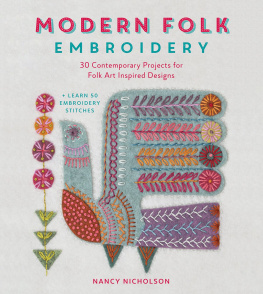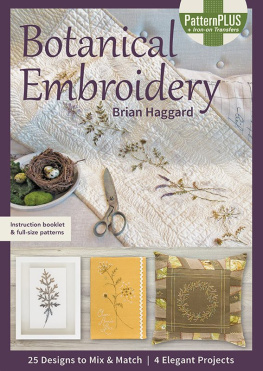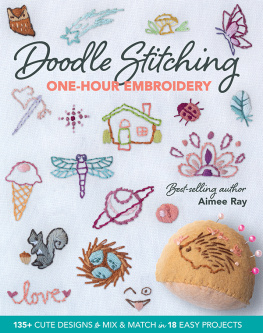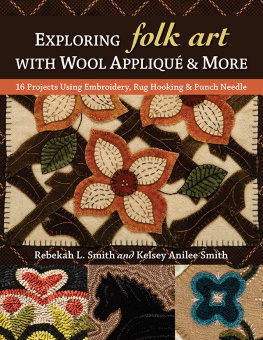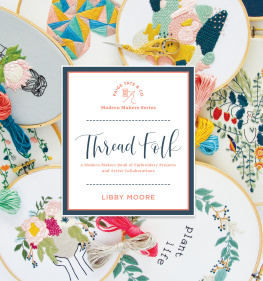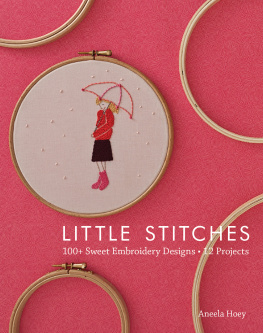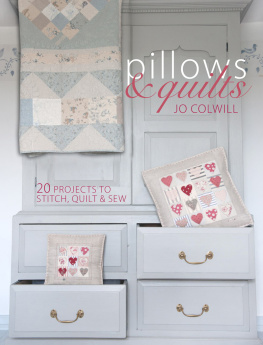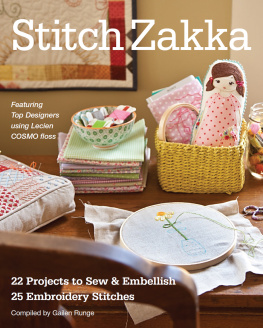Contents
Guide
MODERN FOLK
EMBROIDERY
NANCY NICHOLSON

www.sewandso.co.uk
CONTENTS
I would like to dedicate this book to my mother who set me on this path, and to Tom and Will, my two boys who continue that path into their own very creative lives.
INTRODUCTION
The urge to embellish and decorate the objects around us seems to be fundamental to who we are: its evident even in the earliest traces of humankind. Every culture has its own distinctive way with design. Colour and stitch are very much part of this, apparent everywhere in decorative pattern, from national costumes to home interiors.
I grew up with a heightened awareness of design, particularly textile design. My father Roger Nicholson was a professor of fine art textiles at the Royal College of Art. My mother Joan was a pioneering force in the Needlework Development Scheme of the 1960s and 70s, teaching and writing on new ways with stitch. She was heavily influenced by folk art from across the world, particularly Scandinavia and China. These were my own earliest, strongest influences as I watched her working at home and absorbed her love of decoration.
My mother believed that embroidery could be enjoyed by all and was determined to spread the word. She died a few years ago but would have been thrilled to see the resurgent interest in craft as weve come to appreciate again the simple soothing pleasures of working steadily with our hands in thread and fabric.
It was in my mothers spirit of innovation, combined with the inspiration of folk culture, that I started to produce my own range of embroidery kits, and I have now written this book to share my designs with you.
TOOLS AND MATERIALS

Listed here are all the tools and materials you will need to complete the projects. If you are a keen stitcher, you may already have most of these to hand, but I hope this serves as a useful checklist. Youll also need access to a sewing machine for making up many of the projects.
NEEDLES
While it is always good to have a variety of needles in your sewing box, I have used only two types of needle for the project embroideries: a tapestry needle with a blunt end and wide eye, size 22, and crewel embroidery needles, sizes 3 and 5.
STRANDED EMBROIDERY COTTON (FLOSS)
This is thread made of six strands and these can be pulled apart to the required thickness. In general, I have used three strands for the project embroideries. Be sure to buy a quality brand such as Anchor or DMC. Youll find that it comes in a huge range of colours.
TAPESTRY WOOL (YARN)
I use Anchor or Appletons tapestry wool (yarn) in either 2-ply or 4-ply, although you could use leftover yarn from your knitting stash. Youll need to use a tapestry needle when embroidering with yarn.
SCISSORS
Youll need a collection of good-quality scissors: a pair of general purpose scissors for cutting card templates; a pair of dedicated fabric cutting scissors; and sharp embroidery scissors for snipping your threads. I use a pinking cutting wheel to cut the zigzag edge on felts, but you could use pinking shears if you prefer.
FABRICS
You can embroider on just about anything, so take a look at what you have to hand and experiment. For the embroideries onto felt, I have used a heathered felt that has a marled effect, so the colours are much more subtle than with nylon felts (see ). For the embroideries onto fabric, Ive mostly used linen, which can be stabilized for embroidery by applying an iron-on interfacing. For the tote bag I chose hardwearing ticking fabric, which is great to embroider onto as the lines are easy to follow when stitching. For bag linings, choose lightweight cotton.
TRANSFER TOOLS
- Air-erasable pen
- Iron-on transfer pen
- Pencils and tracing paper
- Thin card for making templates
EMBROIDERY HOOP
It is a matter of personal choice whether you use a hoop for keeping your fabric taut as you embroidery I prefer to simply hold my embroidery in my hand.
OTHER ESSENTIALS
- Pins
- Polyester stuffing
- Machine sewing cotton in project appropriate colours
- Brooch backs
- Self-cover buttons
- Decorative buttons
- Cotton tapes in project appropriate colours
- Black elastic cord (rounded)
- Tape measure
- Craft foam 23mm (approx. 18in) thick
STITCH LIBRARY
If you are a beginner you will soon come to know what experienced embroiderers understand, that embroidery is a relaxing and mindful craft. It is so easy to get started with even just a few basic stitches. Just choose your project, transfer your design (for methods, see ), thread your needle, make a knot at the end of your thread and get stitching.
Over the next few pages I am going to show you to how to work the stitches used for the projects and motifs featured in this book, plus a few more for you to discover as you develop your embroidery skills. These stitches have been organized into colour-coded families. Accompanying each project, I have provided you with embroidery suggestions to guide you as you stitch and these show the stitches I have used, but as you become more confident you can substitute these with your own choice of stitches.
Throughout the book there are pages of stitch combinations for you to explore, offering you exciting opportunities to combine stitches in a variety of ways to create very different effects. It is my hope that you will be inspired to work rich and varied combinations of your own.
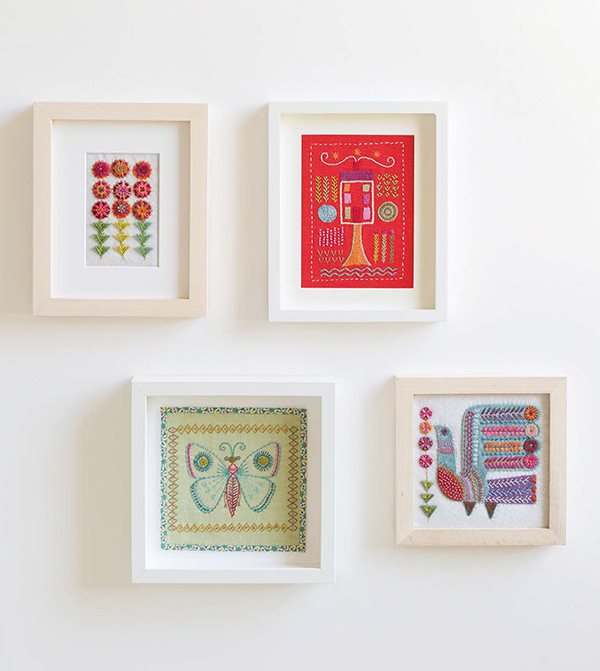
RUNNING STITCH FAMILY
Running stitch can look wonderful worked on its own to define the hem of a pinafore dress or the edge of a sampler picture, but it is also the start point for so many exciting embroidery stitches. The basic stitch can be decorated in so many ways, whipped and laced to great effect.

Running Stitch

Back Stitch

Whipped Running Stitch


Laced Running Stitch

Double Laced Running Stitch

